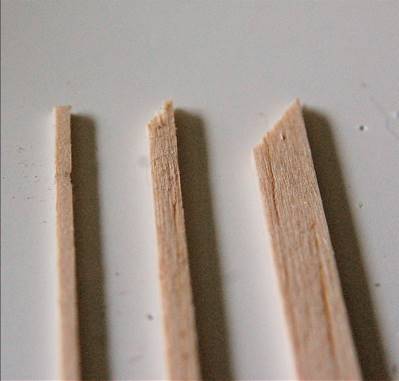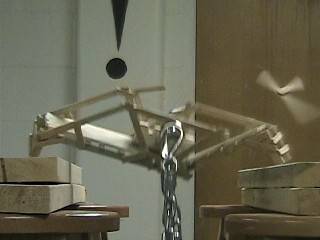Balsa Wood Bridge - How to Build a Strong Balsa Wood Bridge
Balsa wood bridge building is an educational technology that is often used to promote subjects areas such as engineering, physics, static equilibrium and building trades. While some of the bridges are created during the regular school curriculum in high schools and colleges, much more popular application of this technology can be found in various competitions that bring together not only contestants from various schools but also hobbyist and engineers who want to be challenged by the various restrictions and challenges.
Schools often include the balsa bridge building sessions in the curriculum, trying to promote practical application of knowledge that students learned during a section or unit covering a related physics or engineering topic. The core forces that govern the stability of loaded and unloaded bridges are Compression (pressing of the bridge component into itself, which eventually leads to buckling) and Tension (the force that wants to rip bridge’s components apart, which eventually leads to snapping).
The bridge building is also used extensively as a tool that can guide students to understand the desired subject area better, learn more about structural design or the process of building bridge structures.
The process of building small bridges involves taking small individual pieces (sticks) of balsa wood, modifying end points to fit the chosen design carefully gluing the pieces one to another until the fully functional bridge framework is created. While the bridges can also be created from smaller, lightweight and easily manageable building materials such as toothpicks or popsicle sticks, bridges created using balsa wood are much more durable and versatile. Because of this added layer of complexity, bridge building projects that are done before high school are usually not utilizing balsa wood.
Balsa wood bridge competition requirements
The goal of almost each balsa wood bridge competition is to build a bridge that can withstand the greatest weight before it fails. However since there is so much variety between each competition, students are often instructed to comply with a vast array of additional challenges, restrictions, and rules.
Most common balsa wood truss bridge designs that are used in competitions are of course Warren, Pratt, and Howe. Advanced bridges are usually focused on designs based on arched, cantilever and bowstring bridges.
Some of the most common competition requirements are:
- Requiring builders to achieve at minimum set bridge span
- Restricting the maximum mass of the bridge
- Restricting the physical size of the bridge
- Restricting the size and shape of structural elements of the bridge (the individual pieces of balsa wood)
- Restricting the amount of glue that can be used during the construction
- Limiting the types of glue that can be used for connecting pieces of balsa wood
- Requiring the minimum or maximum height of the roadway
- Requiring that roadway remains drivable for the selected type of vehicle of the specified size
- Restricting the building techniques of the bridge (for example, banning the use of parallel joining pieces)
- Requiring the use of the specific truss designs (which is often done so that students can apply their knowledge from recent studies)
- Requiring the building of the specific types of bridges (bowstring, arched, cantilever, truss...)
- Limiting the use of paints or other forms of sealant
- Limiting the use of non-glue materials such as string wires, sticky tapes, gussets, pins
- Setting limits on the angle at which bridge member pieces can be joined one to another (for example, at least 30 degrees).
- Limiting the use of lamination
- Setting the limits on the minimal and maximum width of the bridge
- Setting the limits on how long balsa wood bridges have to be dried before they can be deemed eligible for competition
Balsa wood properties
While the bridges can be made from various types of woods, balsa remains one of the most popular because of its core properties.
Pros of balsa wood material:
- Cheap
- Lightweight
- Easy to cut and sand
- Changes mass in different humidity
Cons of balsa wood material:
- Weaker than some other types of wood
- It can have inconsistent density, which may lead to unexpected buckling or snapping when under strong load
The best alternative to balsa wood is bass wood. It is heavier and more expensive, but it is also stronger, resistant to crushing, with same strength throughout entire stick, it can bend more, and it can hold together better at glued joints.
Balsa wood bridge testing and scoring
The main test for all balsa wood bridges is seeing how much downward force can it endure. The testing can focus on specific points on the bridge (it’s usually a middle of the bridge) and different ways of applying the force. Only when the bridge breaks can the judges determine how well made it is. If you are making your bridge for a competition, be ready to see it break.
The bridges are usually tested using the following techniques:
- Hanging a weight (usually container that can be filled with various smaller weights) from the specified points on the bridge. The container is filled with known weights until the bridge breaks. Instead of weights, some competitions that value high accuracy add sand or water into the container until bridge breaks, and then measure the final weight of the container.
- Using a mechanical or pneumatic testing device that pushes down of the bridge until the bridge breaks. Some devices of this type can also exert predetermined forces or patterns of forces on the bridge. They can also save the bridge from being destroyed by sensing exactly when the bridge starts to buckle and executing immediate reduction of testing forces.

Most competitions use the hanging weight testing since it is easy and cheap to setup, and also produces spectacular and dramatic bridge destruction events.
Scoring of bridges is done using the following techniques:
- How much weight exactly each bridge can support
- Determining exact strength to weight ratio (or structural efficiency)
Balsa wood bridge tips
- Before building bridge, create elaborate design plan that you will try to execute
- Keep the log of all your bridge designs, so that you can learn from your mistakes
- Practice, practice, practice
- Measure twice, cut once!
- Build your bridge away from humidity
- Build your bridge in clean and well-lit area
- Make sure you are managing sharp cutting tools properly
- You can remove humidity from your bridge by keeping it in a closed container with few grains of rice or silica gel packets
- Don’t overdo the glue and keep your hands clean from oils and grease
- Take advantage of lateral bracings, which will prevent your bridge from twisting
- You will save money by buying balsa wood sheets and then cutting your pieces
- The shorter the piece, the more forces it can endure
- Be careful not to sand too much material from balsa wood
- Learn the properties of your chosen glue
- Don’t leave your glue open after you use it
- The best way to prepare for the competition is to build a bridge that you can fully test (and destroy). Leave enough time for building an another (and hopefully enhanced) bridge.
- If you can, record your tests using a camera. The best way to analyze what has caused the destruction of your bridge is to record the test using the high-framerate camera (many modern smartphones support this feature).
